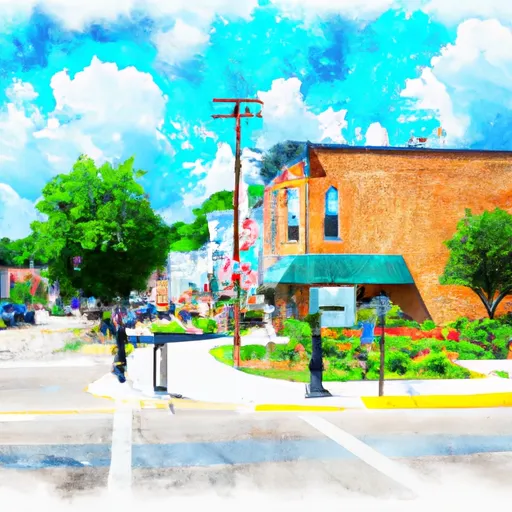-
 Snoflo Premium
Snoflo Premium
Get unlimited access to all our content
With no Ad interruptions! - Start Your Free Trial Login with existing account
Millville
Eden Index
Climate
6.4
•
Recreation
2.8
•
Community
•
Safeguard
3.5/10

Millville, Minnesota is a small town located in southeastern part of the state. It experiences a continental climate characterized by hot summers and cold winters. Summer temperatures average around 80°F (27°C), while winter temperatures can drop as low as 15°F (-9°C). Precipitation is evenly distributed throughout the year, with an average of 30 inches (76 cm) annually.
The town is situated near the Whitewater River, which is known for its clear waters and abundant wildlife. Hydrology constituents in Millville include the Whitewater River and its tributaries, providing opportunities for fishing, canoeing, and kayaking. The river also offers scenic views and peaceful hiking trails along its banks.
Millville is surrounded by natural areas, including state parks and forests, offering a range of outdoor recreation opportunities. Whitewater State Park, located just a few miles away, features miles of hiking and biking trails, picnic areas, and camping facilities. Visitors can explore the park's limestone bluffs, forests, and scenic overlooks. The area is also renowned for its excellent birdwatching, with various species, including bald eagles, peregrine falcons, and warblers, being spotted throughout the year.
In conclusion, Millville, Minnesota offers a diverse outdoor experience with its continental climate, rich hydrology constituents, and numerous recreation opportunities, making it an ideal destination for nature enthusiasts and outdoor adventurers.
What is the Eden Index?
The Snoflo Eden Index serves as a comprehensive rating system for regions, evaluating their desirability through a holistic assessment of climate health, outdoor recreation opportunities, and natural disaster risk, acknowledging the profound impact of these factors on livability and well-being.
Climate Health Indicator (CHI): 6.4
Millville receives approximately
844mm of rain per year,
with humidity levels near 83%
and air temperatures averaging around
7°C.
Millville has a plant hardyness factor of
4, meaning
plants and agriculture in this region thrive during a short period during spring and early summer. Most
plants will die off during the colder winter months.
By considering the ideal temperature range, reliable water supplies, clean air, and stable seasonal rain or snowpacks, the Climate Health Indicator (CHI) underscores the significance of a healthy climate as the foundation for quality living.
A healthy climate is paramount for ensuring a high quality of life and livability in a region, fostering both physical well-being and environmental harmony. This can be characterized by ideal temperatures, reliable access to water supplies, clean air, and consistent seasonal rain or snowpacks.
Weather Forecast
Streamflow Conditions
Upper Mississippi-Black-Root
Area Rivers
Upper Mississippi-Black-Root
Snowpack Depths
Upper Mississippi-Black-Root
Reservoir Storage Capacity
Upper Mississippi-Black-Root
Groundwater Levels
Recreational Opportunity Index (ROI): 2.8
The Recreational Opportunity Index (ROI) recognizes the value of outdoor recreational options, such as parks, hiking trails, camping sites, and fishing spots, while acknowledging that climate plays a pivotal role in ensuring the comfort and consistency of these experiences.
Access to outdoor recreational opportunities, encompassing activities such as parks, hiking, camping, and fishing, is crucial for overall well-being, and the climate plays a pivotal role in enabling and enhancing these experiences, ensuring that individuals can engage in nature-based activities comfortably and consistently.
Camping Areas
| Campground | Campsites | Reservations | Toilets | Showers | Elevation |
|---|---|---|---|---|---|
| Chacauqua River Access | None | 721 ft | |||
| Yenruogis County Park | None | 799 ft | |||
| Waubonsie Trail Park | 7 | 784 ft | |||
| Finger Lakes State Park | None | 725 ft | |||
| Rothwell Park | None | 858 ft | |||
| Manhattan Bridge Access | None | 644 ft | |||
| McGowen Rec Area | 12 | 857 ft | |||
| Lake Fisher | 6 | 840 ft | |||
| Drakesville City Park | 6 | 886 ft | |||
| Macon Co Park | None | 873 ft |
Nearby Ski Areas
Catastrophe Safeguard Index (CSI):
The Catastrophe Safeguard Index (CSI) recognizes that natural disaster risk, encompassing floods, fires, hurricanes, and tornadoes, can drastically affect safety and the overall appeal of an area.
The level of natural disaster risk in a region significantly affects safety and the overall livability, with climate change amplifying these risks by potentially increasing the frequency and intensity of events like floods, fires, hurricanes, and tornadoes, thereby posing substantial challenges to community resilience and well-being.
Community Resilience Indicator (CRI):
The Community Resilience Indicator (CRI) recognizes that education, healthcare, and socioeconomics are crucial to the well-being of a region. The CRI acknowledges the profound impact of these elements on residents' overall quality of life. By evaluating educational resources, healthcare accessibility, and economic inclusivity, the index captures the essential aspects that contribute to a thriving community, fostering resident satisfaction, equity, and social cohesion.

